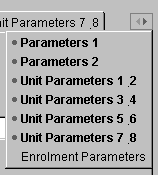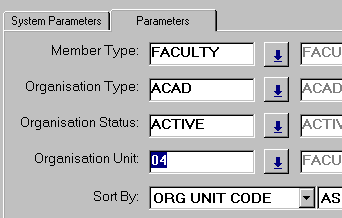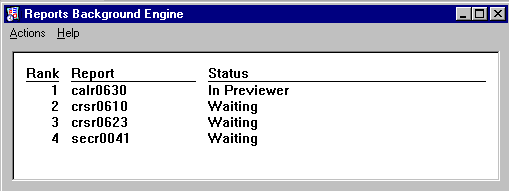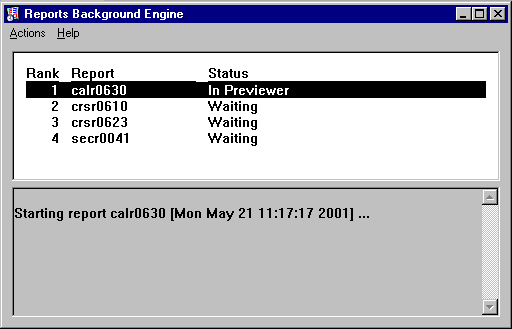All About Standard Reports and Jobs
Standard
reports and jobs refers to the reports and jobs supplied with, and run from
within, Callista.
Reports
and jobs may be run immediately, scheduled to run as soon as possible or scheduled
to run at a specified time (batch mode). Not all reports or jobs can be run
in all three modes. The ability to run a report or job in a particular mode
depends on its allowable modes (these are not able to be modified by users),
the parameter form type of the report or job and whether or not the user is
recorded in Callista as a Novice Interface user (maintained in SECF0066).
The following paragraphs refer to reports and jobs that can be accessed directly
rather than through Job Scheduler.
This
section describes the common features of reports and jobs, how they are run
in immediate mode and how they are scheduled to run as soon as possible. Information
about scheduling reports and jobs to run at a specified time is contained
in the Job Scheduler section.
A
complete listing and description of standard reports is provided under Standard Reports Listing. A listing of jobs and their descriptions is provided
under List of System Processes.
How to Access Reports and Jobs
Reports and Jobs may be accessed in the same way as forms, i.e. from the basic Callista navigation menus, via the zoom menu item from some forms or directly through the Job Scheduler. Because different people may see different menu structures, the exact location of a particular menu item may vary. Report and job menu items can be recognised by their distinctive icon.
![]() The Job/Report icon.
The Job/Report icon.
To
start a report, or job, select the appropriate menu item. This will display
the report/job's parameter form.
Parameter Forms
Parameter forms are the means by which the 'running' of a report is controlled. They are so called because they permit the entry of parameters (variable values) that influence the way a report is produced (system parameters) and the information that is contained in the report.
The
following picture shows the common features of a typical parameter form.
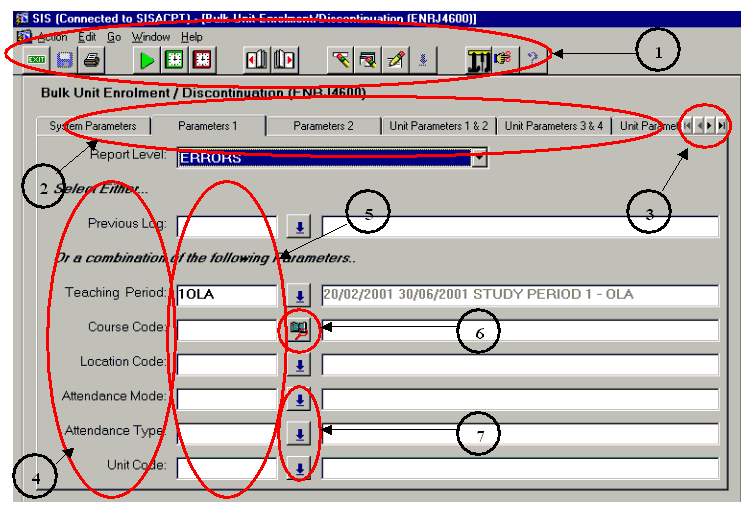
1.
Menu Bar and Tool
Bar

Most
commands can be performed either by clicking on a toolbar icon or by selecting
the corresponding menu item from one of the menu bar options.
|
Icon |
Menu
Item |
Function |
|
|
Action
> Close |
Closes
the parameter form and returns to the previous form or menu |
|
|
Action
> Save |
Function
is disabled in parameter forms. |
|
|
Action
> Print |
Print
an image of the current screen. |
|
|
Action
> Run Report |
Run
the report/job immediately. |
|
|
Action
> Schedule ASAP |
Schedules
the report/job to run as soon as a timeslot is available. |
|
|
Action
> Schedule |
Opens
the Maintain Request Details form (JBSF5210) to enable the report/job to be manually scheduled
(commonly referred to as Batch Mode) using Job
Scheduler functionality. |
|
|
Go
> Previous Page |
Displays
the next or previous parameter screen where a report or job has more
than one. Alternatively, click on a parameter form tab to display the
corresponding parameter screen. |
|
|
Edit
> Clear Record |
Re-initiates
the selected field for entry of a parameter. |
|
|
Edit
> Clear Form |
Re-initiates
the parameter form for entry of parameters. |
|
|
Edit
Field |
Opens
a separate window for editing the selected field. This may be useful
for editing lengthy parameter values. |
|
|
Edit
> List of Values |
Displays
list of values (LOV) for field in which cursor is located. Button is
disabled for fields with no LOV. |
|
|
Go
> Maintain Person Preferences |
Opens
the Maintain Person preferences form (SECF0066). This is useful for
checking your default email and printer addresses. |
|
|
Go
> Maintain Request Job Run |
Opens
the Maintain request Job Run form (JBSF5300) where the progress of the
report or job can be checked. |
|
|
Help
> Help |
Opens
the Callista User Manual in the context of the current report or job. |
2.
Parameter Form Tabs
![]()
Each
tab represents a set of parameters. Click on a tab to display its set. When
a tab's label is followed by two asterisks (eg. Course Parameters**), this
indicates that mandatory parameters are incomplete in that tab's set. When
mandatory parameters are completed for a tab, the asterisks no longer display.
Note that when accessed via the Web, the System Parameters tab is not displayed.
3.
Scroll buttons
|
|
Client-server
version |
|
NCA
(Web) version |
The
arrows to the right of the parameter tabs can be used to scroll through the
tabs. When accessed via the Web, the arrows display a pick list from which
a tab can be chosen.
4.
Parameter Labels
|
|
Parameter
labels are the names of the fields where parameters can be entered.
They are reasonably self-explanatory and relate closely to the field
names used in Callista forms. Where necessary, some instruction is included
in the parameter form. Eg. 'Select Either') The use of
particular parameters is described in the help for the report or job. Fields
with labels in red text are mandatory and must have a data value entered.
When data is entered in a mandatory field, its label changes to black
text. When invalid data is entered in a field, either its list of values
will be invoked (if it has one) or its field label and the data value
will change to red text to signify that the value must be changed. |
5.
Parameter Fields
|
|
Parameter
values are entered into these fields. Depending on the nature of the
field, values may be keyed, selected from a list of values, returned
after a lookup in the Find Person or Find Course forms or may be ticked
or un-ticked, in the case of a checkbox. |
6.
The Find Course button
The
Find Course button ![]() invokes a form where course codes can be looked
up using search criteria. Clicking on the OK button in the Find Course form
returns you to the parameter form and inserts the course code in the appropriate
parameter field. The Find person button
invokes a form where course codes can be looked
up using search criteria. Clicking on the OK button in the Find Course form
returns you to the parameter form and inserts the course code in the appropriate
parameter field. The Find person button ![]() performs a similar role in the location of particular
person records.
performs a similar role in the location of particular
person records.
7.
List of Values (LOV)
Buttons
An
LOV button displays a list of the permissible values for the adjacent parameter
field. Where an LOV exists you can key a value directly in the field, select
a value from the list or leave the field blank if it is not mandatory.
System Parameters
System
Parameters determine how a report will be run and the nature of the output
produced. The system parameters are similar on all parameter forms and are
shown below.
Note
that parameter forms accessed via a web browser do not have a System Parameter
tab. Their system values default from those contained in the report/job definition
and the Person Preferences of the user.
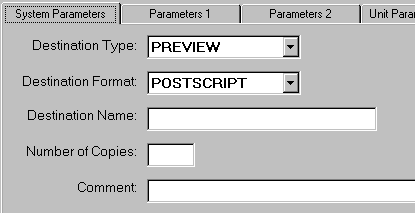
|
|
System Parameter Fields
|
Field Name |
Description |
|
Destination Type |
The
type of device to which the report will be sent. Options are:
|
|
Destination Format |
The
format that the output will be created in. Options are:
·
PDF - Read and print with Adobe Acrobat
reader.
·
HTML - Read and print with most web browsers.
·
POSTSCRIPT - formatted for postscript
printers. |
|
Destination Name |
The
name to which the report output will be sent. Options are:
|
|
Number of Copies |
The number of copies to be printed. If Destination Type is not PRINTER this parameter is ignored. If the parameter is left blank it will default to 1. |
|
Runtime Comment |
Permits you to add a comment to the Header and Trailer pages of the report. |
Report/Job Parameters
Report/Job
Parameters are similar to query criteria. The user specifies data values to
be used in a report's data extraction process with the result that only data
matching the specified criteria is reported. A portion of a report parameter
form is shown below. In this example, by specifying organisational unit 04,
a report is produced containing only information related to this organisational
unit.
Each
report has its own set of report parameters. Parameter values are usually
selected from lists of values (LOVs), invoked via LOV buttons to the right
of the fields. (as shown below against the Member Type field) This ensures
that only valid values are used. Some parameter forms contain parameters for
other purposes. In the pictured example, the Sort By parameter is used to
specify the order of presentation of data in the report.
Job
parameters primarily specify the set of data to be processed by the job.
|
|
Default Parameters
In some cases, default parameter values are displayed upon entering the parameter form, avoiding the need to enter values. The default values are normally either the most commonly used or the most likely values for the parameter. Default values can generally be overridden.
Running Reports and Jobs
|
Running reports or jobs from the basic Callista menus |
·
Run immediately
·
Schedule as soon as possible
·
Schedule through Job Scheduler |
Reports Background Engine Window (displayed only in Immediate mode)
The Reports Background Engine window (illustrated below) provides a simple and powerful way to manage a queue of reports. The window opens automatically when a report parameter form is opened but is minimised in the Windows toolbar. It provides a display of all the reports queued to run and enables you to monitor the status of the reports, move reports up or down in the queue, and remove items from the queue.
|
Reports Background Engine Window |
|
|
Reports Background Engine Window with Log displayed |
|
|
Using the Reports Background Engine window |
|
|
Action |
Instruction |
|
To cancel the currently executing report from the Oracle Reports Server |
Select the report with Rank 1 and then select Cancel Report from the Actions menu in the menu bar. |
|
To remove a queued report from the list. |
Select it and then select Remove Job from the Actions menu in the menu bar. |
|
To move a report up or down in the list. |
Select it and drag it to a new location. |
|
To show/hide a log for the Oracle Reports Server session |
Select Show/Hide Log from the Actions menu in the menu bar. A separate pane for log messages will be displayed or hidden. |
Exiting a Report
To exit a running report, use the Reports Server window.
To exit a report displayed on screen in a Preview window, select the Close button from the toolbar at the top of the screen.
Report Output
Report Structure
Standard reports are designed around a common template, promoting consistency in the layout and appearance of reports. Important parts of each report include:
- Header Page - The first page of a report - includes the report title, output filename (if applicable), who ran the report, the run date and time and any parameter values used.
- Trailer Page - The last page of a report - includes the text 'END OF REPORT' and may optionally include the report title.
- Body Pages - These pages contain the detail of the report.
Some aspects of the header and trailer pages are institution configurable, including the institution name. Content of these pages is maintained via the Maintain Report Details form (SECF0022), maintained by System Administrators.
Navigating Around the Displayed Report
Navigation within a report displayed on screen is achieved via navigation buttons at the top of the screen as illustrated below.
![]()
|
Navigation Button |
Use |
|
|
Prints the report to your specified printer when Preview was nominated as the destination type. The option also exists under the File menu to generate the report output to a file. |
|
Page
Setup |
Allows
selection of printing and printer options. |
|
|
Creates
a new email message in your default email application that contains
the report output as an attachment. The Destination Format should be
either PDF or HTML. |
|
New
Previewer |
Opens
a new preview window for the same report. |
|
Close Previewer |
Closes the Preview window and exits the current report. |
|
Zoom In |
Increases the size of text for easier reading of fine detail. |
|
Zoom
Out |
Reduces
the size of text to enable more text to be viewed in a single screen. |
|
First |
Displays the first page of the report. (Header page) |
|
Prev |
Displays the previous page in the report. |
|
Next |
Displays the next page in the report. |
|
Last |
Displays the last page of the report. (Trailer page) |
|
Page |
Permits direct navigation to the page specified in the adjoining (editable) field. Note that this numbering refers to all pages including the Header page. The numbers printed on pages include only report Body pages. |
|
Help |
This
is Oracle Reports help, not help for the displayed report. |
Printing Reports
See
'Navigating Around the Displayed Report' above.
Last
modified on 11 March 2002
